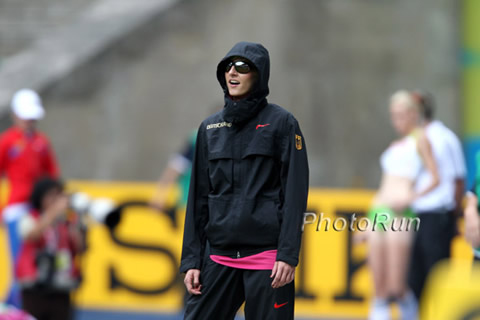This is the final piece on the Big Ten Outdoor Track & Field Championships by our columnist, David Hunter. Pay particular attention to how Dave places the Big Ten in the firmament of conferences. I like how Dave described Beth Alford-Sullivan and her focus for her teams and her university. Ms. Alford-Sullivan is one of the good ones. I only see her in passing, at USATF Convention or perhaps a championship.

Big Ten Outdoor Track & Field Championships – Day Three
Big Ten: Ready For The Big Time?
March 12, 2013
Columbus, Ohio
Conference track & field championship meets are different. For the athletes, there is a special element of pride that accompanies the pointed competition to prove you are the best in your conference. Nobody wants to come up short against a fellow competitor from a dreaded rival of your own university. Everybody wants that quiet sense of accomplishment that comes with proving you are the best in the conference in your event.
But there’s another slant on conference championships as well. While winning is the obvious focus, everybody – the athletes, the coaches, the schools – also wants their fellow conference  competitors to be strong, to compete fiercely, to make your conference – and the conference championships you win – important.
competitors to be strong, to compete fiercely, to make your conference – and the conference championships you win – important.
Beth Alford-Sullivan – Penn State’s accomplished coach of both the men’s and women’s track & field programs – knows how competitive the Big Ten is. Goal-oriented, Alford-Sullivan is still chasing that dream of getting the stars and planets properly aligned to capture outdoor team titles for the men and the women on the same day. It hasn’t yet happened for her. “This conference is too tough,” confides Penn State’s leader. But how do Big Ten track & field teams stack up against the powerhouse conferences like the PAC-12 and the SEC? ” I think we are as tough or tougher because of the fact our teams are balanced,” says Alford-Sullivan. “You look at the PAC-12 and you’ll have a few sprint schools and many distance schools. And then you turn around and look at the SEC and you have a ton of sprint schools, and very few distance schools. And then you look at the Big Ten and you’re getting hit everywhere,” she explains. “So if you are weak and haven’t recruited in an area, you can’t catch them,” she adds with a laugh. “That’s what our sport should be. And that’s probably one of the strengths of our conference. We run deep with very good, balanced teams.” Those in attendance Sunday at the Jesse Owens Memorial Stadium knew that Day Three would reveal which Big Ten teams have that depth and balance this spring.
Day Three began with an upbeat hometown surprise as a quartet of Ohio State sprinters gave the host school an opening final day victory in the women’s 4 x 100 relay in 44.76. Aided by uncharacteristically crisp stick passes at all three exchanges, the Lady Buckeyes ran away and hid – never giving the favored Illinois women a chance. A powerful anchor run by sprint star Ashley Spencer lifted the Fighting Illini [45.58] to the runner-up position. In the men’s 4 x 100, Iowa provided a mild surprise when a strong anchor leg by senior Josh Larney powered the Hawkeyes to an unexpected win in 40.20 – bettering pre-race favorites Nebraska [40.23] and Illinois [40.29].
In the 1500, the Michigan women grabbed 25 points as the Lady Wolverines went 1-3-4-5. A strong move by senior Amanda Eccleston over the final 200 gave her the advantage she needed to capture the victory in 4:20.75.
The point harvest thrust the Michigan women into the team lead with 65 points with Nebraska [63] and Penn State [62] in close pursuit. But as the afternoon progressed, it was clear that Alford-Sullivan’s Nittany Lionesses were – quietly and without fanfare – amassing meaningful points in nearly every event.
The much-anticipated men’s 1500 provided a strategic surprise. A confident Andrew Bayer – the defending Big Ten and NCAA champion in the 1500 – responded to the starting gun by unhesitatingly rushing to the lead. It was an uncharacteristic move that caught his competitors napping. Never relenting, the Indiana senior quickly built a significant lead that reached 25 meters as he raced by 800 in 1:58. Efforts by Wisconsin’s Rob Finnerty and Penn State’s Robby Creese to cut into the Hoosier’s lead late into the race were effective, but far too late. Bayer defended his title and completed his wire-to-wire win in 3:44.24. Creese finished second [3:45.39] with a fast-closing Chris Fallon of Ohio State [3:48.37] getting up for third.
After the 1500, the men’s team race remained close: Nebraska’s 54.5 points gave it a slim one point lead over Wisconsin.
Illinois sophomore sensation Ashley Spencer showed why she may be the U.S.’s next big-time long sprinter. After turning in a sizzling anchor leg on the Fighting Illini’s 4 x 100 team, Spencer toyed with the field in capturing the 400 title. Her winning time of 52.27 amidst the swirling wind was 1.67 seconds ahead of runner-up Megan Geyen of Minnesota. Later, she prevailed in her 200 showdown with 100 champion Mahagony Jones of Penn State. Her 23.21 clocking gave her a clear margin over the Nittany Lion star’s 23.37 runner-up time. Spencer capped her impressive afternoon by anchoring the Fighting Illini’s 4 x 400 relay – coming from way off the pace to blow by the anchors from Ohio State and Penn State.
In the men’s dashes, Iowa’s sprint seniors prevailed. Justin Austin captured the 100 title with a wind-allowable winning time of 10.27, to edge teammate Josh Larney [10.39]. Larney bounced back to take the 200 in 20.86.
In the 400, Stephon Pamilton of Illinois grabbed the title in 46.06. But Nebraska – mimicking the effective strategy of the Penn State women to add to the Huskers’ growing team score margin – rang up 14 points when the freshman duo of Levi Gipson [46.44] and Cody Rush [46.70] grabbed the other two podium positions.
Spirited field events on the final day of competition featured several sterling performances. With one magnificent opening throw, Ohio State freshman Bill Stanley broke the Big Ten javelin championship record [239’8″ – Bill Pettner 2007] with a mark of 246’10” [75.23m]. OSU senior Mike Hartfield completed his double in the horizontal jumps with a winning triple jump of 51’3″ [15.62m] – good enough to edge Minnesota senior Oladipo Fagbemi [50’10¾” / 15.51m].
Two final round successes led to dramatic wins. In the women’s triple jump, Nebraska senior Mara Griva uncorked a sixth-round triple jump of 43’5¼’ [13.24m] to squeak past Michigan State sophomore Tori Franklin [43’2¼” / 13.16m]. And a clutch shot put performance by Chad Wright earned 10 important points for the Huskers when the Nebraska junior’s final round bomb of 63’7½” [19.39m] was good enough to better Wisconsin junior Danny Block [63’4¼” / 19.31m].
A monster field of 41 athletes launched off on the women’s 5000 final. Easy circuits at sub-80 second pace allowed the pack to stay bunched during the earlier stages of the race. Illinois sophomore Alyssa Schneider led the pack through halfway in 8:18 as it became clear that any aspiring point scorers would have to run negative splits. A slight increase in the race tempo shook off a few pretenders, but a dozen runners still remained in contention with 4 laps remaining. One lap later, only 5 – Schneider, Penn State’s Brooklyne Ridder, Wisconsin’s Caitlin Comfort, Iowa’s Mareike Schrulle, and Michigan State’s Leah O’Connor – remained. Comfort – who had garnered the 10,000 title Friday evening – jumped up to take a short-lived lead with 800 to go. But by the bell, Schrulle and O’Connor were alone to battle for the title. O’Connor – showing no lingering fatigue after her come-from-behind steeple win the previous day – made one strong decisive move that was left unanswered with 300 remaining. The MSU sophomor
e hit the line in 16:09.46 to complete a tough and impressive steeple/5K double. Schrulle – 3 seconds back – hung on for second.
Opening laps at 68 second pace quickly spooled out the large field in the men’s 5000 final. Those pesky Badgers soon revealed their clever team tactics as Wisconsin’s Alex Brill, Reed Connor, and Maverick Darling – Friday’s 10,000 victor – shared early pacing chores. Lurking in the pack was Indiana’s Andrew Bayer – coming back just 2 hours after his run-away 1500 victory. The Hoosier star was running easily – undistracted by the Badger shenanigans. As the pace heated up as the race entered the final 4 laps, Darling inexplicably stepped off the oval – leaving his teammate Connor to wrestle with Bayer for the title. Three laps at 66 second pace separated the duo from the field as Connor had a stride on Bayer at the bell. The Hoosier made his move with just over 200 remaining and appeared to be sailing on to the win. But Conner wasn’t done. Charging hard off the final turn, the Badger looked as if he would nail Bayer before the line. But a quick glance alerted Bayer of impending disaster. Bayer [13:54.71] was able to summon up just enough to fend off Connor [13:54.90] at the line – and complete a noteworthy 1500/5000 double. Bayer – who covered the final 400 in 60 seconds – looks ready for Hayward Field next month.
In the battle for the team title, workmanlike performances throughout the day by two broadly-talented teams had methodically dispatched the customary meet-concluding outcome-determinative drama of the 4 x 400 relays – rendering them of no real consequence in the final team standings. Just as Alford-Sullivan had forecasted, team depth and balance had proved to be the key. And this day, it would be the Nebraska men’s squad and the Penn State’s women’s contingent that would prevail.
“I thought we had a really good chance,” confided Husker head coach Gary Pepin. “I’m a pessimist, so I don’t really like to project ourselves out there as scoring a lot of points. But I felt like we had a real good chance. It would have been really disappointing if it [Nebraska’s team victory] hadn’t happened,” explained Pepin – who has guided Nebraska’s track & field fortunes for 34 years. “Overall, we were really pleased.”
Alford-Sullivan was jubilant in the wake of victory by her women’s squad. “There really weren’t any big surprises today,” noted the Nittany Lion leader. “We ended up with 20 different women scoring in 17 of the 21 events. Everyone just kept doing their job. I think Mahagony Jones stood out for us today. Just all around, everybody was strong.”
This spring’s Big Ten outdoor track & field titles – and the bragging rights which accompany them – belong to the Penn State women and the Nebraska men. And as the post conference championship season now unfurls, it will soon be time for all Big Ten track & field athletes to show their skills on the national stages in a way that will support Alford-Sullivan’s assessment of the Big Ten’s depth and balance.
~Dave Hunter





















